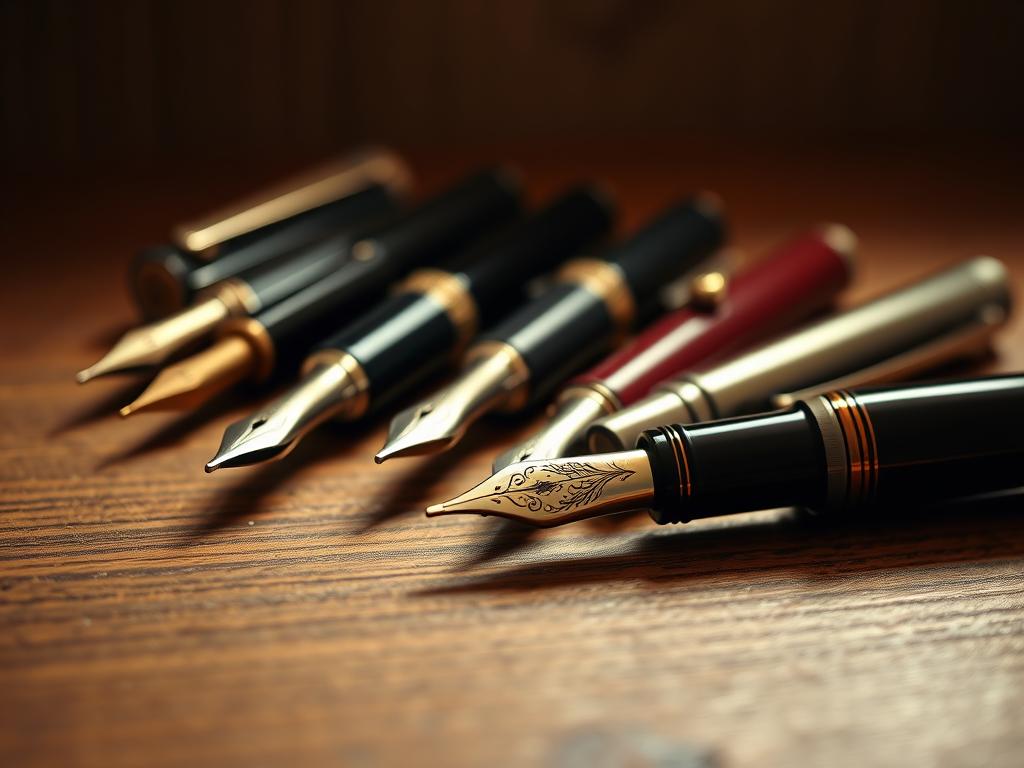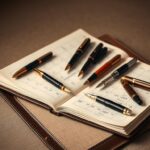For many, owning a finely crafted writing instrument isn’t just about utility—it’s about connecting with history. Classic pens from brands like Montblanc, Parker, and Waterman blend timeless design with exceptional craftsmanship. These pieces often feature hand-polished nibs and materials that modern manufacturers rarely replicate, making them treasured by enthusiasts and collectors alike.
This guide explores how to navigate the world of pre-owned writing tools. Whether you’re drawn to the sleek lines of a Parker 51 or the intricate details of a restored Montblanc 149, understanding their background ensures informed decisions. Many sellers professionally recondition these items, preserving their functionality while honoring their legacy.
Renowned brands such as Namiki, Graf von Faber-Castell, and Caran d’Ache are celebrated for blending artistry with precision. For example, Parker’s innovative designs from the mid-20th century remain benchmarks for durability. Similarly, restored Montblanc models often retain their original elegance, showcasing why they’re sought after decades later.
From identifying authentic pieces to evaluating restoration quality, this article offers practical insights. It also highlights how these instruments serve as heirlooms, merging practicality with storytelling. Whether you’re starting your collection or expanding it, this resource simplifies the journey.
Key Takeaways
- Classic writing instruments from brands like Montblanc and Parker combine historical value with enduring craftsmanship.
- Restored models, such as the Montblanc 149, often maintain their original quality through professional reconditioning.
- Understanding a pen’s history and construction helps ensure authenticity and long-term satisfaction.
- Brands like Namiki and Graf von Faber-Castell are known for blending artistic detail with functional excellence.
- This guide serves as a practical resource for both new and seasoned collectors.
The Allure of Buying Vintage Luxury Pens
Collectors treasure these instruments not just for their function but as portals to bygone eras. Their designs reflect decades of innovation, from streamlined Art Deco curves to post-war practicality. Take the Montblanc Hemingway, inspired by the author’s adventurous spirit, or the Parker Duofold Moderne, a Jazz Age icon. Each piece carries stories of craftsmanship that modern replicas strive to echo.

Historical Significance and Timeless Collectability
Early 20th-century models revolutionized how people wrote. Unique filling systems, like lever-fill mechanisms or vacuum plungers, became signatures of their time. For instance, Waterman’s “safety cap” design from the 1920s prevented leaks—a breakthrough still admired today. These features make older pieces highly sought-after, especially when restored with original parts.
“A well-maintained classic pen isn’t just a tool—it’s a bridge between generations.”
Modern Appeal and Investment Value
Today’s enthusiasts appreciate how brands reinterpret heritage designs. Limited editions, such as Graf von Faber-Castell’s annual releases, blend old-world aesthetics with sustainable materials. The market has grown steadily since 1997, with rare models appreciating by 8–12% yearly. A 1950s Parker 51 in mint condition, for example, can fetch over $500 at auction.
| Feature | Historical Models | Modern Interpretations |
|---|---|---|
| Design Inspiration | Art Deco, Industrial Revolution | Minimalist retro styles |
| Filling System | Lever-fill, eyedropper | Cartridge converters |
| Materials | Celluloid, ebonite | Recycled resins, titanium |
Whether used daily or displayed as art, these items balance nostalgia with practicality. Their enduring charm lies in details—hand-engraved nibs, patinaed barrels—and the patience required to preserve them.
Exploring Top Vintage Pen Brands
Behind every storied writing instrument lies a brand that shaped its legacy. From Art Deco marvels to minimalist innovations, these creators blend technical mastery with artistic vision. Let’s explore the icons that define eras and inspire today’s enthusiasts.

Luxury Icons
Montblanc’s 149 model, with its flexible 14k nib, remains a benchmark for precision. Graf von Faber-Castell elevated wood-and-metal designs, like the 1990s Guilloché series. S.T. Dupont’s lacquered finishes, seen in 1970s Olympio models, echo Parisian elegance.
Heritage and Craftsmanship
Pelikan’s piston-fill system, perfected in 1929, still defines reliability. Restored Parker Duofolds from the 1930s showcase celluloid vibrancy. Waterman’s 1950s capillary feeds and Lamy’s 1980s stainless steel builds prove timeless durability.
Innovative Names
Caran d’Ache reimagined geometric patterns in its 1980s Ecridor line. Japanese artisans like Namiki and Nakaya blend urushi lacquer with modern ergonomics. Cross’s 1940s Townsend and Aurora’s limited Optima editions balance retro charm with bold colors.
| Brand | Signature Feature | Collector Highlight |
|---|---|---|
| Montblanc | Hand-tuned nibs | 1950s Meisterstück |
| Parker | Streamlined caps | Restored Duofold Moderne |
| Namiki | Urushi lacquer | Emperor Maki-e editions |
For deeper insights into brand histories, explore our guide to expert reviews. Whether it’s Tibaldi’s 1920s celluloid or Montegrappa’s silver engravings, each piece tells a story worth preserving.
Buying Considerations and Restoration Tips for Vintage Pens
Acquiring historical writing instruments requires equal parts passion and practicality. Whether you’re drawn to Waterman’s early safety caps or Montblanc’s piston mechanisms, understanding evaluation and care ensures lasting enjoyment.
Evaluating Condition, Authenticity, and Value
Start by examining key components. Original nibs on Parker 51 models should bear precise imprints, while Montblanc’s resin barrels show distinct aging patterns. Check for:
- Matching parts: Duofold clips should align with era-specific engravings
- Functional filling systems: Restored lever-fill mechanisms in 1930s Sheaffers often outperform modern alternatives
- Documentation: Certificates or repair logs add 15–30% value
Cosmetic wear like brassing on clips doesn’t always diminish functionality. A 1950s Pelikan with slight scuffs but smooth piston action often writes better than mint-condition replicas.
Restoration and Maintenance Essentials
Professional reconditioning preserves both mechanics and heritage. Experts recommend:
- Soaking dried sacs in talc-free solutions for 48 hours
- Using ultrasonic cleaners on stubborn ink deposits in Waterman feeds
- Replacing cracked nibs with period-correct spares from verified suppliers
“Never force a stuck mechanism—improper tools can erase decades of history.”
For daily care, store instruments horizontally and flush monthly with distilled water. Explore our comprehensive guide for brand-specific maintenance routines. Trusted repair specialists, like those endorsed by the Pen Collectors Guild, ensure delicate items retain their writing charm for future generations.
Conclusion
Collecting classic writing instruments offers more than ownership—it’s a celebration of artistry and history. Brands like Montblanc, Parker, and Pelikan each contribute distinct stories through their designs, from piston-fill innovations to hand-engraved nibs. These items bridge generations, blending practicality with the charm of eras like Art Deco or mid-century minimalism.
Market trends since 1997 show steady growth, with rare models appreciating yearly. Proper care ensures they remain functional heirlooms. Experts recommend evaluating authenticity through imprints, materials, and documentation—details that safeguard both value and legacy.
Whether used daily or displayed, these tools honor craftsmanship while inviting personal connection. For those eager to dive deeper, explore our ultimate guide to collecting fountain pens. Share discoveries on the pen blog or contact specialists for tailored advice. Every piece holds a story—what will yours tell?
FAQ
Why are certain brands like Montblanc or Parker considered iconic in pen collecting?
Brands like Montblanc and Parker pioneered innovative designs and durable craftsmanship, making their historical models highly sought after. Their legacy in fine writing instruments ensures lasting value among enthusiasts.
How can one verify the authenticity of a pre-owned fountain pen?
Authenticity checks include examining engravings, comparing materials to brand archives, and consulting experts. Original packaging or documentation also adds credibility, especially for rare models from brands like Graf von Faber-Castell.
What factors influence the value of older writing instruments?
Rarity, condition, and historical significance play key roles. Limited editions from brands such as S.T. Dupont or Nakaya often appreciate due to their craftsmanship and cultural relevance.
Are restored models from brands like Waterman or Pelikan worth collecting?
Professionally restored pieces can retain value if original parts are preserved. However, over-polishing or replaced nibs might reduce appeal for purists seeking untouched items.
How do modern brands like Caran d’Ache compare to heritage names in collectability?
Brands like Caran d’Ache blend contemporary artistry with traditional techniques, attracting newer collectors. Heritage brands like Aurora or Tibaldi, however, often hold stronger historical prestige.
What maintenance steps prolong the life of a classic fountain pen?
Regular cleaning, using quality inks, and storing nib-up prevents clogs. For models with delicate filling systems, like vintage Pilots, gentle handling ensures mechanisms remain functional.


